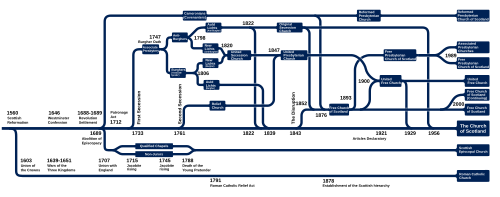| Church | Subsequent history |
|---|
| Aberdeen: Skene Terrace | Founded 1807 as Constitutional Anti-Burgher. Became OSC 1827. Dissolved 1908. |
| Arbroath Maule Street (minority) | Refused to join the CoS in 1956; eventually merged with a congregational church. |
| Auchinleck | Dissolved 1928. |
| Ayr | Dissolved 1944. |
| Balmullo (minority) | Dissolved 1878. |
| Birsay (part) | Joined the CoS in 1956. Became Birsay Swannayside Parish Church, absorbed into Birsay PC 1957. |
| Carluke | Joined the CoS in 1956. Became Carluke Kirkstyle Parish Church. Dissolved 1969. |
| Carnoustie | Joined Free Church 1852, then RPC 1860, then OSC 1876. Dissolved 1919. |
| Cheltenham | Existed as an OSC church c. 1877-1880. Left OSC, still in existence as Whaddon Road Evangelical Presb. Church. |
| Colmonell (part) | Dissolved c. 1878. |
| Coronary and Cartlehill | Received from the Irish Secession Church, 1921. Joined Presbyterian Church of Ireland 1955. |
| Coupar Angus | Dissolved c. 1893. |
| Darvel | Split from Darvel RPC (which had joined the Free Church), joined OSC 1883. Dissolved 1941. |
| Dromore | Formerly Ballylintagh. Majority remained in OSC. United with Toberdoney and joined Presbyterian Church of Ireland 1955. |
| Dundee | Joined the CoS in 1956. Became Dundee Euclid Crescent Parish Church. Dissolved 1968. |
| Edinburgh: Adam Square | Dissolved 1879. |
| Edinburgh: Victoria Terrace | Separated from Adam Square 1857. Dissolved 1956. |
| Glasgow: Bridgeton | Founded as a 'church plant' 1876. Joined the CoS in 1956. Became Binnie Place Parish Church, dissolved 1964. |
| Glasgow: Laurieston | Founded 1872 out of Glasgow Mains Street. Dissolved 1920s. |
| Glasgow: Mains Street | Joined the CoS in 1956. Dissolved 1964. |
| Kilmarnock: Fowlds Street | Dissolved 1947. |
| Kilwinning | Joined the Free Church in 1956. Still in existence, co-joined with Ayr Free Church. |
| Kirkcaldy | Dissolved 1956. |
| Kirkintilloch | Joined the United Free Church 1902. Became Kirkintilloch South Church of Scotland 1929. Dissolved 1951. |
| Kirriemuir | Dissolved some time after 1899. |
| Midlem | Dissolved 1939. |
| Olrig | Joined OSC 1857 from Free Church. Dissolved between 1908 and 1914. |
| Paisley | Split from Paisley RPC (which had joined the Free Church), joined OSC 1885. Joined the CoS in 1956.
Became Paisley Wellmeadow Parish Church. United with St George's East to form Paisley St Matthew's, 1969. |
| Perth | Joined the CoS in 1956. Became Perth St Luke's Parish Church. Dissolved 1958. |
| Pollokshaws: Cogan Street | Joined the CoS in 1956. Became Shawholm Parish Church. United w/ Auldfield to form Pollokshaws 1965. |
| Shottsburn | Joined the CoS in 1956. Absorbed into Kirk o' Shotts Parish Church 1975. |
| Stranraer | Dissolved c. 1920. |
| Thurso (part) | Dissolved 1913. |
| Toberdoney or Ballylintagh | United with Dromore and joined Presbyterian Church of Ireland 1955. |
